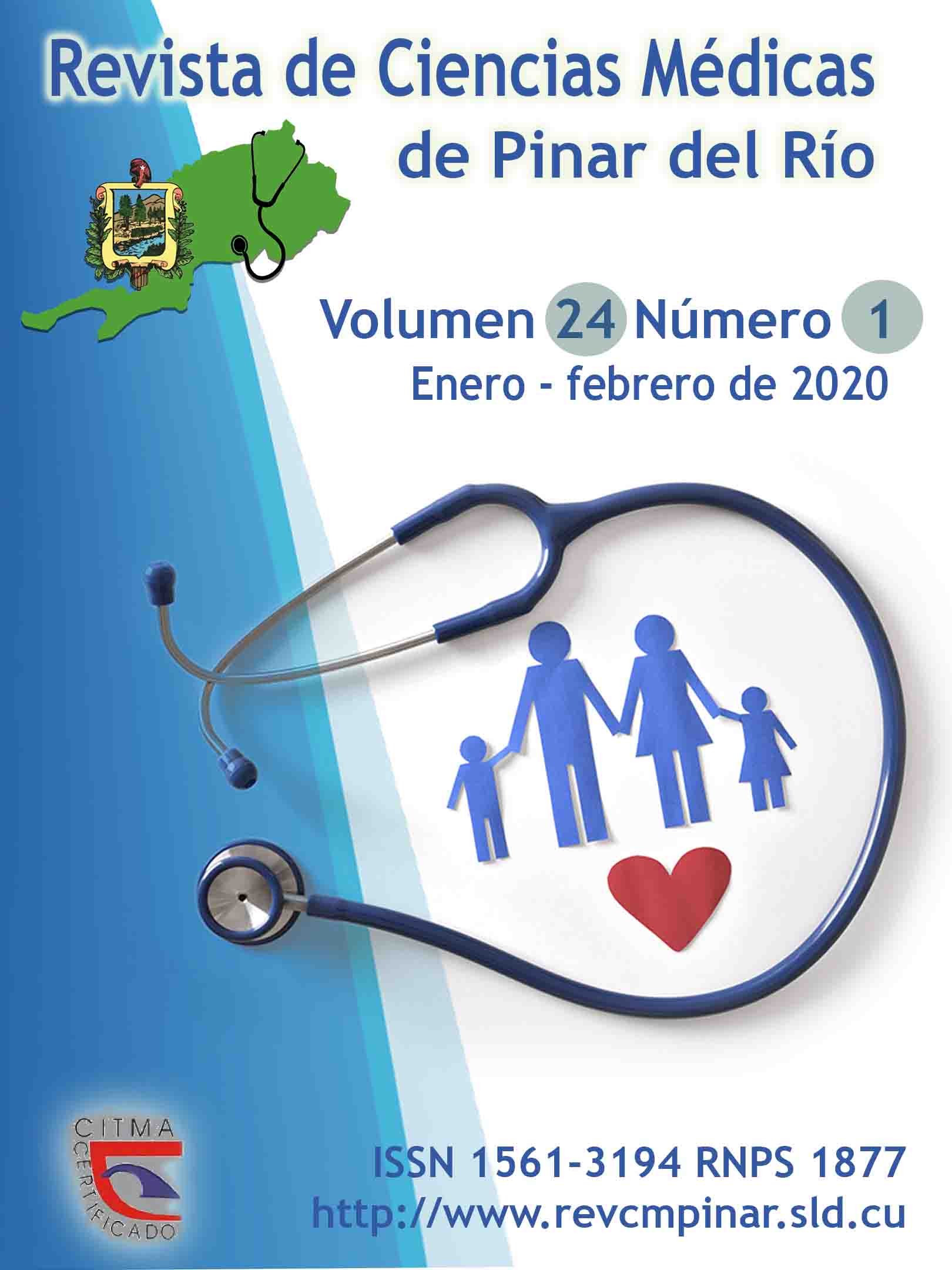Implementation of curricular strategies in the Clinical Propedeutics and Medical Semiology subjects
Keywords:
EDUCATION, HIGHER, STRATEGIES, TEACHING, LEARNING, INTERDISCIPLINARY RESEARCH.Abstract
Introduction: in the pedagogical order, it is necessary to focus on the designs of the subjects in the major of medical sciences with greater pertinence and a sense of integration, and to try to approach diverse formative areas by means of an interdisciplinary and trans-disciplinary method through curricular strategies that strengthen the developmental action of the participating disciplines.
Objective: to evaluate the implementation of curricular strategies in Clinical Propedeutics and Medical Semiology subjects.
Methods: a study was developed based on the dialectical materialistic method, within the framework of educational research, making possible the increase of knowledge, a necessary process facing the theoretical and practical character of the research; theoretical and empirical methods were applied within the first, the historical-logical, systemic-structural and documentary review and in the second group, the application of a questionnaire by means of a comparison list.
Results: all professors recognized the importance of the interdisciplinary characters of the subjects to interact from different points of view and to provide solutions to the same problem. More than the half of professors surveyed demanded the need for pedagogical and didactic recommendations to achieve a satisfactory design of specific actions that comply with curricular strategies in the subjects.
Conclusions: the curricular strategies linked to medical major make possible an interdisciplinary nature, distinguished by a coordinated direction that responds to the graduates exit profile and it is materialized through the interdisciplinary relationships that the subjects make possible, by contextualizing the learning needs from an integrative perspective and a triadic conception energized by the principles which guide this process.
Downloads
References
1. De la Luz y Caballero J. Elencos y discursos académicos. V-3. La Habana: Editorial Imagen Contemporánea; 2001. p. 21.
2. Pérez Guerrero MC, Suárez Fernández M, Carrasco Milanés A. Implementación de estrategias curriculares en asignaturas de segundo año de la Licenciatura en Enfermería. Rev Hum Medí [Internet]. 2013 Abr [citado 02/04/2019]; 13(1): [aprox. 9p.]. Disponible en: http://scielo.sld.cu/scielo.php?script=sci_arttext&pid=S1727-81202013000100010&lng=es
3. Salas Perea RS, Salas Mainegra A. La educación en el trabajo y el individuo como principal recurso para el aprendizaje. Edumecentro [Internet]. 2014 [citado 20/01/2019]; 6(1). Disponible en: http://www.revedumecentro.sld.cu/index.php/edumc/article/view/362/540
4. Rodríguez Neyra ME, Carrasco Feria M de los Á. Metodología para la implementación de estrategia curricular de investigación e informática en la carrera de medicina. ccm [Internet]. 2017 Jun [citado 01/04/2019]; 21(2): [aprox. 12p.]. Disponible en: http://scielo.sld.cu/scielo.php?script=sci_arttext&pid=S1560-43812017000200010&lng=es.
5. Castellanos Simons D. Estrategias para promover el aprendizaje desarrollador en
el contexto escolar. La Habana: Editorial Educación Cubana; 2005. Disponible en: http://www.cubaeduca.cu/media/www.cubaeduca.cu/medias/pdf/5171.pdf
7. Hernández Rodríguez I M, Ferro González B. Formación humanista y modo de actuación del médico. Estrategia para su integración. Rev Ciencias Médicas [Internet]. 2015 Jun [citado 01/04/2019]; 19(3): [aprox. 16p.]. Disponible en: http://scielo.sld.cu/scielo.php?script=sci_arttext&pid=S1561-31942015000300012
8. Roque Herrera Y, Gafas González C, Blanco Balbeito N, Herrera Santana D. Estrategia curricular para desarrollar habilidades investigativas en estudiantes de Medicina. REE [Internet]. 2014 jul. - dic [citado 01/04/2019]; 8(2): [aprox. 7p.]. Disponible en: http://dspace.unach.edu.ec/bitstream/51000/4019/1/UNACH-EC-REV-EU-ESPEJO-2017-0012.pdf
9. López González A, Rabelo Rodríguez Y, Fernández Pérez A, Pérez Díaz C, Velázquez García L. Mapas conceptuales para formación de habilidades profesionales en estudiantes de la carrera de Estomatología. Rev Ciencias Médicas de Pinar del Río [Internet]. 2018 abril [citado 15/05/2019]; 22(2): [aprox. 9p.]. Disponible en: http://www.revcmpinar.sld.cu/index.php/publicaciones/article/view/3392
10. Alonso Chil O, Blanco Aspiazu MA, Hernández Azcuy O, Miralles Aguilera E. MINSAP. Dirección de docencia médica. Comisión nacional de carrera de Medicina [Disciplina: Medicina General, Asignatura: Medicina Interna]; 2018.
11. Ramos Padilla K, Castillo Gato H, Gort Cuba O, Serrano Cisneros T. Estrategia curricular de Medicina Natural y Tradicional en Programa de Formación en Medicina Integral Comunitaria. Rev. Ciencias Médicas de Pinar del Río [Internet]. 2018 agosto [citado 15/05/2019]; 22(4): [aprox. 20p.]. Disponible en: http://www.revcmpinar.sld.cu/index.php/publicaciones/article/view/3477/pdf
Downloads
Published
How to Cite
Issue
Section
License
Authors who have publications with this journal agree to the following terms: Authors will retain their copyrights and grant the journal the right of first publication of their work, which will be publication of their work, which will be simultaneously subject to the Creative Commons Attribution License (CC-BY-NC 4.0) that allows third parties to share the work as long as its author and first publication in this journal are indicated.
Authors may adopt other non-exclusive license agreements for distribution of the published version of the work (e.g.: deposit it in an institutional telematic archive or publish it in a volume). Likewise, and according to the recommendations of the Medical Sciences Editorial (ECIMED), authors must declare in each article their contribution according to the CRediT taxonomy (contributor roles). This taxonomy includes 14 roles, which can be used to represent the tasks typically performed by contributors in scientific academic production. It should be consulted in monograph) whenever initial publication in this journal is indicated. Authors are allowed and encouraged to disseminate their work through the Internet (e.g., in institutional telematic archives or on their web page) before and during the submission process, which may produce interesting exchanges and increase citations of the published work. (See The effect of open access). https://casrai.org/credit/



